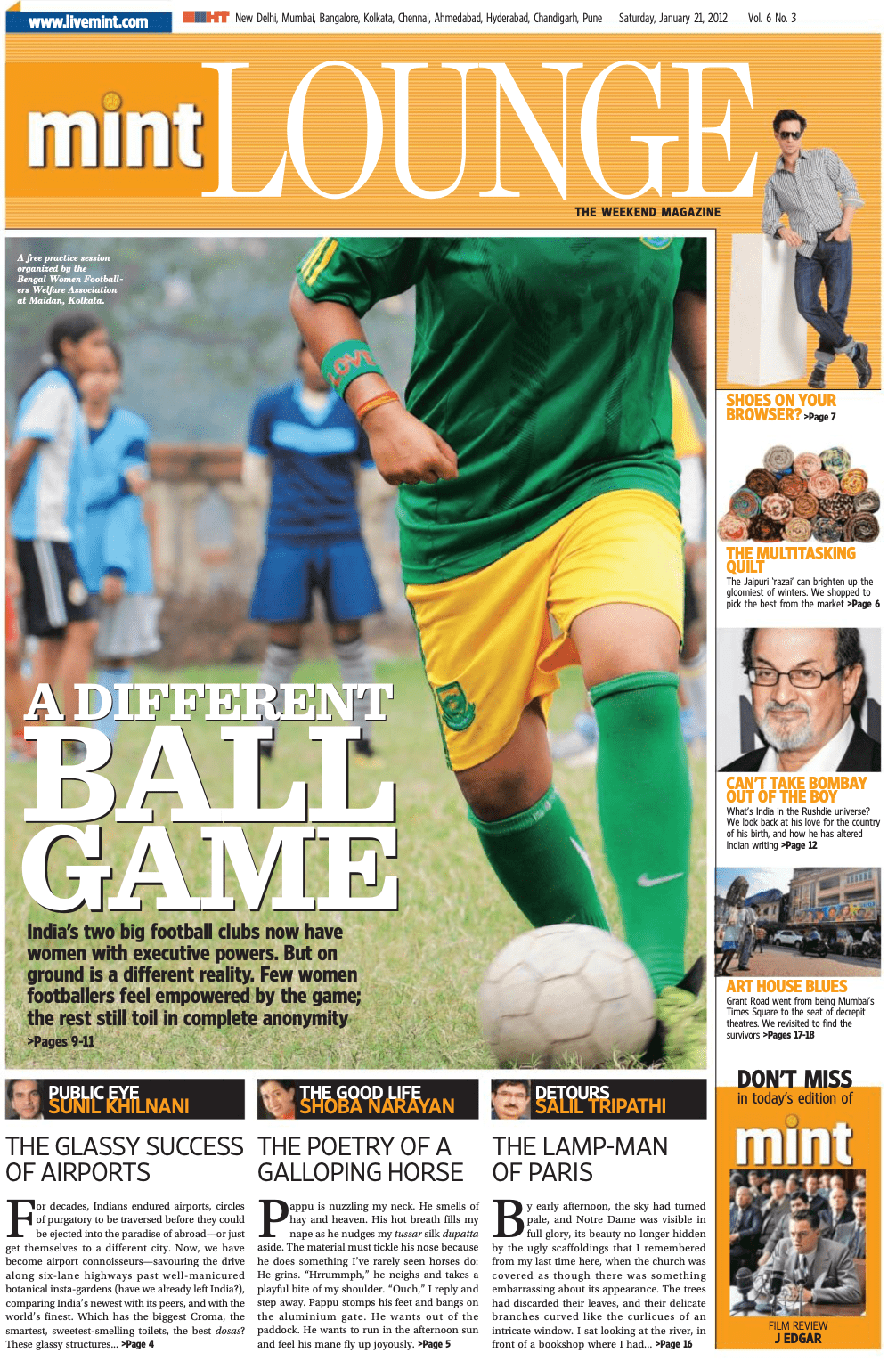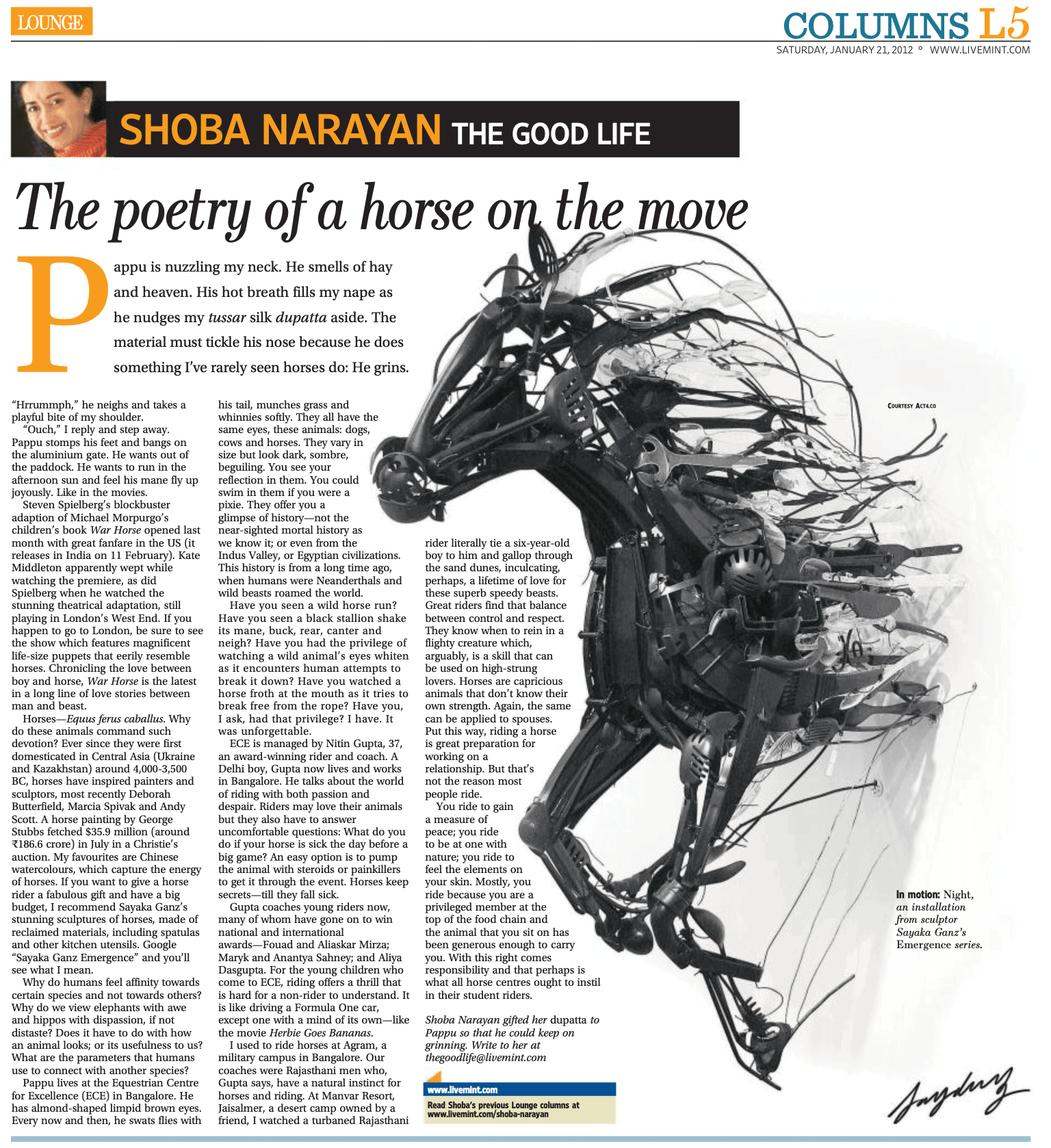About sculpture, horses and Sayaka Ganz’s work.
This one is for Dhruv and Noor
4 min read .

Pappu is nuzzling my neck. He smells of hay and heaven. His hot breath fills my nape as he nudges my tussar silk dupatta aside. The material must tickle his nose because he does something I’ve rarely seen horses do: He grins.
“Hrrummph,” he neighs and takes a playful bite of my shoulder.
“Ouch,” I reply and step away. Pappu stomps his feet and bangs on the aluminium gate. He wants out of the paddock. He wants to run in the afternoon sun and feel his mane fly up joyously. Like in the movies.
Horses—Equus ferus caballus. Why do these animals command such devotion? Ever since they were first domesticated in Central Asia (Ukraine and Kazakhstan) around 4,000-3,500 BC, horses have inspired painters and sculptors, most recently Deborah Butterfield, Marcia Spivak and Andy Scott. A horse painting by George Stubbs fetched $35.9 million (around Rs186.6 crore) in July in a Christie’s auction. My favourites are Chinese watercolours, which capture the energy of horses. If you want to give a horse rider a fabulous gift and have a big budget, I recommend Sayaka Ganz’s stunning sculptures of horses, made of reclaimed materials, including spatulas and other kitchen utensils. Google “Sayaka Ganz Emergence” and you’ll see what I mean.
Why do humans feel affinity towards certain species and not towards others? Why do we view elephants with awe and hippos with dispassion, if not distaste? Does it have to do with how an animal looks; or its usefulness to us? What are the parameters that humans use to connect with another species?
Pappu lives at the Equestrian Centre for Excellence (ECE) in Bangalore. He has almond-shaped limpid brown eyes. Every now and then, he swats flies with his tail, munches grass and whinnies softly. They all have the same eyes, these animals: dogs, cows and horses. They vary in size but look dark, sombre, beguiling. You see your reflection in them. You could swim in them if you were a pixie. They offer you a glimpse of history—not the near-sighted mortal history as we know it; or even from the Indus Valley, or Egyptian civilizations. This history is from a long time ago, when humans were Neanderthals and wild beasts roamed the world.
Have you seen a wild horse run? Have you seen a black stallion shake its mane, buck, rear, canter and neigh? Have you had the privilege of watching a wild animal’s eyes whiten as it encounters human attempts to break it down? Have you watched a horse froth at the mouth as it tries to break free from the rope? Have you, I ask, had that privilege? I have. It was unforgettable.
ECE is managed by Nitin Gupta, 37, an award-winning rider and coach. A Delhi boy, Gupta now lives and works in Bangalore. He talks about the world of riding with both passion and despair. Riders may love their animals but they also have to answer uncomfortable questions: What do you do if your horse is sick the day before a big game? An easy option is to pump the animal with steroids or painkillers to get it through the event. Horses keep secrets—till they fall sick.
Gupta coaches young riders now, many of whom have gone on to win national and international awards—Fouad and Aliaskar Mirza; Maryk and Anantya Sahney; and Aliya Dasgupta. For the young children who come to ECE, riding offers a thrill that is hard for a non-rider to understand. It is like driving a Formula One car, except one with a mind of its own—like the movie Herbie Goes Bananas.
I used to ride horses at Agram, a military campus in Bangalore. Our coaches were Rajasthani men who, Gupta says, have a natural instinct for horses and riding. At Manvar Resort, Jaisalmer, a desert camp owned by a friend, I watched a turbaned Rajasthani rider literally tie a six-year-old boy to him and gallop through the sand dunes, inculcating, perhaps, a lifetime of love for these superb speedy beasts. Great riders find that balance between control and respect. They know when to rein in a flighty creature which, arguably, is a skill that can be used on high-strung lovers. Horses are capricious animals that don’t know their own strength. Again, the same can be applied to spouses. Put this way, riding a horse is great preparation for working on a relationship. But that’s not the reason most people ride.
You ride to gain a measure of peace; you ride to be at one with nature; you ride to feel the elements on your skin. Mostly, you ride because you are a privileged member at the top of the food chain and the animal that you sit on has been generous enough to carry you. With this right comes responsibility and that perhaps is what all horse centres ought to instil in their student riders.






A flowing articulation. Permit me to highlight a small personal experience:
There is a lesson of life that I had observed during my brief stint with riding. The lesson is about the varying shades of life, emerging from the sport, passion and love for horses. Out of the varying walks of a horse; the gallop is the smoothest, canter the bumpiest and trotting the slowest. Similarly in life, to reach the fastest and the smoothest phase, one must sustain and master the preceding stages.
A rider too knows the distinctly different comforts of these walks, but masters and sustains the entire beast, for there is no shade of life that comes with a singular stroke.
Yes a random burst of thoughts, but then your article instigated it positively.
Thank you itsaround. That is a beautiful sentiment.
When it comes to nursing home’s employees, seek both quality and quantity.
Their experience is shoulpd be explained too you in detail,
and it may also be a good ieea to do some reading on the
matters yourself. There is a sectioon on Links and Resources that providdes
dozejs of pamphlets annd videos relating to thhe family law court experience including how to choose the right forms, what to do with
them, how to rrange tthe domestic violence paperwork, what
tto do if you’re served with that forms, what the child support and custody mediation techniquess are like,
and more.
I was wondering iif you ever considered changing the page layout
of your website? Its very well written; I love what youve got to
say. But maybe you could a little moore in the way of content so people could connect with it better.
Youve got an awful lot oof text for only having one or 2 pictures.
Maybe you coiuld space itt out better?
That is really attention-grabbing, You’re an overly skilled blogger.
I’ve joined your rss feed and sit up for in quest of extra
of your great post. Additionally, I have shared
your website in my social networks